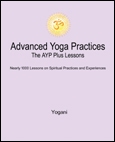|
Public Home | Plus Home | Main Lessons | Tantra Lessons | Public Forum | Plus Forum | Downloads | Books Topic Paths | Search | Training-Retreats | Testimonials | Survey | Interviews | MultiMedia | Contact | Donate |
|
Advanced Yoga Practices Note: For the Original Internet Lessons with additions, see the AYP Easy Lessons Books. For the Expanded and Interactive Internet Lessons, AYP Online Books, Audiobooks and more, see AYP Plus. Lesson T38 - Pornography, Compulsive Habits, and Tantra (Audio)
From: Yogani New Visitors: It is recommended you read from the beginning of this tantra yoga archive, as previous lessons are prerequisite to this one. The first lesson is, "What is tantra yoga?"
A: Thank you for writing and sharing. Your desire to deal with an obsession for pornography and masturbation means the solution is already being formed. Desire is the first step. Your meditation is bringing up inner silence, and that is calling your inner energies to a higher purpose. In this situation, "vices" can become a means for yoga. By this I mean that, with a strong desire for a higher purpose (bhakti), you can make good use of the methods of tantra to transform your sexual obsessions. If you have not already, please review the tantra lessons. There you will find techniques, including the holdback method, blocking, and the count method, which can be used during any kind of sexual activity in solo or partner mode to achieve the primary goals of tantric sex -- preservation and cultivation of sexual energy. This is brahmacharya. But let's be clear about an important point. Nowhere in the AYP lessons is sexual activity beyond our personal norm encouraged for the purposes of tantra. Knowing sexual techniques is not a license to engage in excesses we normally would not. I say this because there has been some misunderstanding about it. For example, on the last tantra lesson #T37 regarding the use of sexual fantasies for tantra when they happen, some have asked if this is a license to indulge in sexually covetous desires. No it is not. But if the desires are happening, we will do better to make good use of them with tantric techniques than to try and squelch them into karmic repressions that can rise again later on. With bhakti, sitting practices, and tantric methods, we can transform these to a higher purpose within our nervous system. Then the energies will be contributing to our enlightenment, and be a burden to us no more. The same thing goes for pornography and other sexual feelings and behaviors that we may be obsessive about. They are not encouraged for their own sake. But if they are happening, if the tendency and conduct are there already, then we can redirect the energy through bhakti and tantric methods. So, whatever our sexual tendencies may be -- whether they would be considered normal or abnormal by us or anyone else -- they can be redirected through yoga and tantric methods. You are experiencing this already with the rise of your desire to overcome what you see as a destructive behavior. Yes, it is destructive. But you don't necessarily have to shut it off. Maybe better to redirect it to a higher purpose. In doing that, the tiger of our unruly sexual obsession can be tamed to permanently serve a higher purpose, rather than caged, only to eat us later when the tiger escapes again -- and it will. Obviously, if our conduct is such that it breaks the law or seriously endangers ourself or others, then that conduct should be stopped immediately. The permanent transformation of our nervous system to naturally express the blissful inner silence and ecstasy that are inherent within us is the key to overcoming all obsessive behaviors. This is the role of yoga. Whether it be a simple desire for truth (bhakti), sitting practices, asanas, tantric sexual methods, or joyfully engaging in service to others, all of these are tools to promote purification and opening. The more aspects of good yoga practice we can incorporate in our daily routine in an orderly fashion, the sooner we will be seeing our obsessions melting into our steadily rising enlightenment. So, keep up your practices, and add more as you are able without undo strain. The procedures of "self-pacing" should always be applied. The topic paths on the web site lists lessons for this important aspect of practice -- self pacing, which is about regulating practices is such a way so as to achieve maximum progress without creating undue discomfort or risk. If obsessive habits are particularly strong, then yoga practices alone may not be enough. Our nervous system is a window to the infinite. Yoga cleans the window in very refined ways. If we have an addiction that is especially strong, then obstructions could be accumulating on our spiritual window faster than yoga can clean them off. Then our ability to meditate or practice other yoga methods could be hampered. A strong addiction related to alcohol, tobacco, drugs, money, food or sex, can hold us back. What can we do in this situation? The "Twelve Step program" developed originally by Alcoholics Anonymous in the 1930s is a highly effective means for dealing with compulsive habits, and has been expanded to cover every kind of compulsive/addictive behavior. If yoga is not able to clean the window due to a deep-rooted compulsive habit, then the twelve step program can be a useful compliment. The goals of the twelve step program are consistent with yoga, and whether we consider ourselves to be compulsively addicted or not, developing a familiarity with the principles of the twelve steps is very worthwhile. It is up to each of us to decide our course in life, and take the necessary steps to travel our path. I wish you all success on yours. Enjoy! The guru is in you. Discuss this Lesson in the AYP Plus Support Forum Note: For detailed instructions on the methods of tantra in relation to the broad scope of yoga practices and the enlightenment process, see the AYP Tantra book. Also see AYP Plus.
|
|
|
|
Join the Mail List:
AYP Retreats
eBooks - PDF, EPUB
FREE eBooks with
SAVE with Bundled
|

























